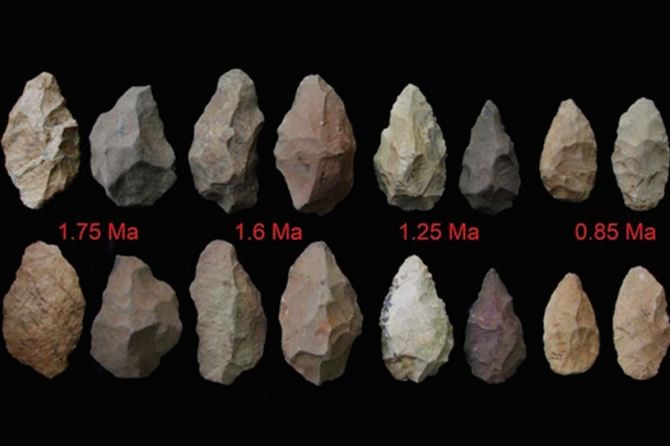The oldest known stone tools in the world were made some 3.3 million years ago, which would make these newly discovered implements older than modern humans.
Archaeologists working in the Kenyan Rift Valley that discovered the tools said the set of 20 stone flakes and anvils are some 700,000 years older than stone tools from Ethiopia that previously held this record. These tools predate the earliest fossils representing our genus, Homo, by 500,000 years.
What these tools suggest is that stone tool manufacture didn't begin with Homo as previously held but with a more primitive member of the human family.
Archaeologist Sonia Harmand, of New York's Stony Brook University believes the artifacts were made either by australopithecines similar to Lucy (a fossilized female hominid of the species Australopithecus afarensis discovered in 1974 and also known as AL 288-1), or by Kenyanthropus, a 3.2 to 3.5 million-year-old (Pliocene) hominin fossil discovered in Lake Turkana, Kenya in 1999.
The tools were discovered at a site called Lomekwi 3 on the western shore of Lake Turkana. Since 2011, archaeologists have uncovered dozens of tools at Lomekwi 3, including flakes, cores and anvils from both the surface and below ground.
"The cores and flakes we recovered are clearly knapped and are not the result of accidental or natural rock fracture," said Harmand.
"The Lomekwi 3 knappers were able to deliver sufficient intentional force to detach repeatedly series of adjacent and superposed flakes and then to continue knapping by rotating the cores." The team determined the age of the tools based on their stratigraphic position relative to two layers of volcanic ash and a magnetic reversal of known ages.
Knapping is the shaping of flint, chert, obsidian or other similar fracturing stones through the process of lithic reduction to manufacture stone tools.
The tools from Lomekwi 3 are larger than the stone tools from the site of Gona in Ethiopia that were previously the oldest on record and larger than the rocks that chimpanzees use to crack open nuts.
According to Harmand, preliminary observations suggest the Lomekwi toolmakers intentionally selected big, heavy blocks of very hard raw material from nearby sources even though smaller blocks were available. They used various knapping techniques to remove the sharp-edged flakes from the cores.
Until now, the earliest known stone tools were those discovered at Gona in Ethiopia and dated to 2.6 million years ago. These tools belonged to a tool making tradition known as the Oldowan, so called because the first examples were found more than 80 years ago at Olduvai Gorge in Tanzania by famous paleoanthropologists, Louis and Mary Leakey.
Harmand claims the newly discovered tools are different enough from the early Oldowan implements to warrant a new name: the Lomekwian.
Exactly what the Lomekwi knappers used their tools for isn't clear. Animal bones recovered at the site don't show any signs of human activity. But evidence from another site does suggest that hominins (the group that includes Homo sapiens and its extinct relatives) were butchering animals back then.
The discovery of the Lomekwi tools has reignited the debate as to whether hominins made the "Dikika marks", but it shows that near contemporaries of the Dikika hominins made implements capable of leaving behind such marks.
Scientists working at the site of Dikika, Ethiopia in 2010 where fossils belonging to Lucy's species had previously turned up said they had recovered 3.4 million year-old animal bones bearing distinctive marks. They argued hominins had made the marks in the course of slicing meat off the bones with stone tools.
The claim caused heated debate with some scientists saying the alleged cut marks were instead the result of the bones having been trampled by passing animals. Others suggested they were bite marks from crocodiles.




























